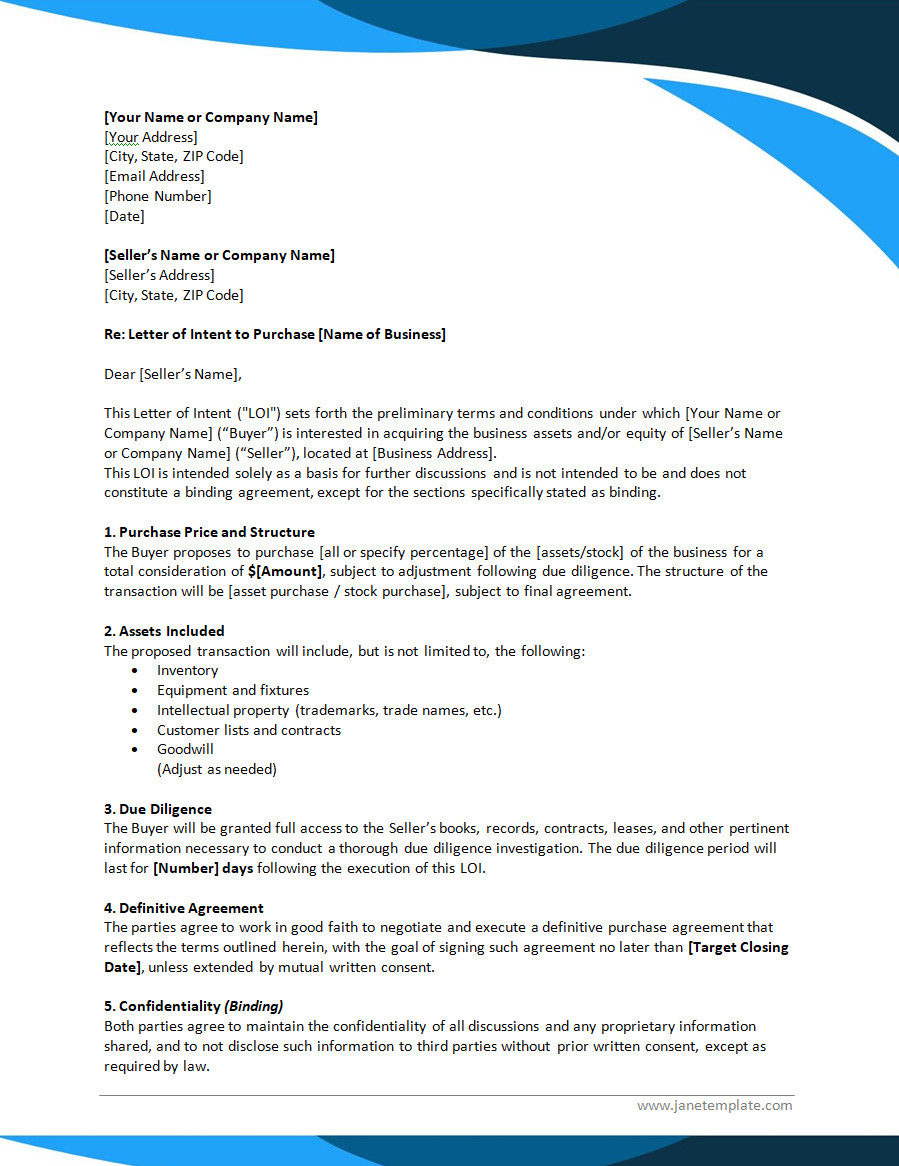Are you considering buying a business? A crucial step in the acquisition process is drafting a letter of intent (LOI).

What Is a Letter of Intent?
A Letter of Intent (LOI) is a non-binding document used in business acquisitions to outline the key terms of a potential deal before the formalization of an agreement. It typically includes the proposed price, payment terms, due diligence steps, and exclusivity period.
While not legally binding overall, certain provisions—like confidentiality, exclusivity, and non-compete clauses—can be enforceable. The LOI sets the groundwork for negotiation, clarifies intentions, and helps avoid future misunderstandings.
It also defines the due diligence process, outlining what information will be shared and the timeline for review. Though preliminary, an LOI plays a vital role in ensuring a smooth path toward a final agreement.
Pros and Cons of Using an LOI in Business Acquisitions
- Pros:
- Provides a framework for negotiations
- Helps clarify intentions and expectations
- Serves as a roadmap for the acquisition process
- Can expedite the deal-making process
- Cons:
- May lead to misunderstandings if not drafted carefully
- The non-binding nature could result in either party walking away from the deal
- It can be time-consuming to negotiate and finalize
- Could limit the flexibility of the parties during the due diligence process
What Should a Letter of Intent Include?
A well-crafted letter of intent should include the following key elements:
- Proposed Purchase Price: Clearly state the amount the buyer is willing to pay for the business.
- Payment Terms: Outline the proposed payment schedule, including any upfront payments, installments, or earn-outs.
- Due Diligence Process: Define the scope and timeline for the due diligence process, including access to financial records, contracts, and other relevant information.
- Exclusivity Period: Specify the timeframe during which the seller agrees not to negotiate with other potential buyers.
How to Write a Letter of Intent to Purchase a Business
Writing an effective letter of intent to purchase a business requires careful attention to detail and clear communication of your intentions. To ensure that your LOI is well-received and sets the stage for a successful acquisition process, follow these steps:
- Research the Business: Before drafting the LOI, conduct thorough research on the business you are looking to acquire. Understand its financials, operations, and market position to inform your offer.
- Introduce Yourself: Start the LOI with a brief introduction of yourself or your company. Clearly state your interest in purchasing the business and your intentions moving forward.
- Outline the Key Terms: Clearly outline the key terms of the deal in the LOI, including the proposed purchase price, payment terms, due diligence process, and any other important conditions. Be specific and detailed to avoid any confusion.
- Express Your Commitment: Show your commitment to the acquisition by expressing your enthusiasm for the business and your willingness to move forward with the deal. This can help build trust with the seller.
- Include a Deadline: Specify a deadline for the seller to respond to your proposal. Setting a clear timeline creates a sense of urgency and can help move the negotiation process forward.
- Seek Legal Review: Before finalizing the LOI, it is crucial to seek legal advice to ensure that all terms and conditions are legally binding and protect your interests. A legal review can help identify any potential issues and mitigate risks.
- Address Contingencies: Consider including contingency clauses in the LOI to address potential issues that may arise during the due diligence process. This can help protect both parties and provide a framework for addressing unforeseen challenges.
- Be Professional and Concise: Maintain a professional tone throughout the LOI and avoid unnecessary details. Keep the document concise and focused on the key terms of the deal to ensure clarity and effectiveness.
- Proofread and Revise: Before sending the LOI, carefully proofread the document for any errors or inconsistencies. Make revisions as needed to ensure that the LOI accurately reflects your intentions and aligns with your goals.
- Follow Up: After sending the LOI, follow up with the seller to confirm receipt and address any questions or concerns they may have. Open communication is key to moving the negotiation process forward.
Letter of Intent Template to Purchase a Business
A letter of intent to purchase a business is a critical document that sets the stage for a potential acquisition deal. By clearly outlining the key terms and conditions of the transaction, an LOI can help both parties navigate the negotiation process with clarity and transparency.
Start using our free letter of intent template to purchase a business today to outline key terms clearly, show serious intent, and lay the foundation for a smooth negotiation process.
Letter of Intent to Purchase a Business – Word